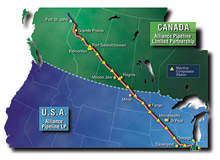

The Alliance pipeline system transports natural gas from the Canadian states of British Columbia and Alberta to Chicago in the US state of Illinois. On an average, the company supplies 1.6 billion cubic feet per day (cfpd) of natural gas to Chicago.
Alliance was formed by a partnership of Alliance Pipeline LP (Alliance USA) and Alliance Pipeline Limited (Alliance Canada).
Alliance USA owns the US side of the pipeline, while Alliance Canada owns the Canadian portion. Alliance Canada is jointly owned by Enbridge Income Fund (50%) and Veresen (50%), and Alliance USA is jointly owned by Enbridge Inc (50%) and Veresen (50%).
Alliance pipeline route
The Alliance Pipeline System became operational in December 2000. It is 3,719km long and transports natural gas from north-east British Columbia and north-west Alberta to Chicago for further distribution across North America. The pipeline runs underground through Saskatchewan, North Dakota, Minnesota and Iowa, before ending in Illinois.
In the first quarter of 2010, the system added a receipt point from Pecan Pipeline in North Dakota on the Alliance USA pipeline near Bantry in North Dakota.
The system connects the Chicago area with two local natural gas distribution systems and five interstate natural gas pipelines, which provide shippers with access to natural gas markets in mid-western and north-eastern US and eastern Canada.
Pipeline system infrastructure
The Alliance pipeline system consists of a 3,000km integrated high-pressure natural gas mainline pipeline located in Canada and the US. The system connects with an NGL extraction facility (the Aux Sable extraction facility) in Channahon, Illinois, near the terminus of the system, which extracts NGLs from the natural gas transported on the system.
The pipeline has three connections – two in North Dakota and one in Iowa – delivering small amounts of natural gas for ethanol production plants.
The Alliance Canada pipeline comprised a 1,560km-long natural gas mainline pipeline. Approximately 730km of lateral pipelines are connected to the system’s mainline and 51 receipt point locations, primarily at natural gas processing facilities in north-western Alberta and north-eastern British Columbia (with one receipt point in south-eastern Saskatchewan), and related infrastructure.
The Alliance USA pipeline consists of a 1,440km-long natural gas mainline pipeline, ten delivery points (two in North Dakota, one in Iowa and seven along the delivery header near Chicago) and related infrastructure owned by the company. It is connected with the Alliance Canada pipeline at the Canada-US border near Carnduff, Saskatchewan, where the two operate as an integrated pipeline system.
Alliance pipeline extension / developments
A new interconnect facility close to Bantry, North Dakota, was completed and put into service in February 2010. The new facility establishes an interconnection between the Alliance pipeline and the Prairie Rose pipeline, which is 76 miles long and has a diameter of 12in.
The interconnection facilitates distribution of natural gas and natural gas liquids from Bakken. It carries 40 million cubic feet per day of these products on the US portion of the pipeline.
Alliance constructed three meter stations at Septimus and Sunrise in British Columbia, and Pine Creek in Alberta. The company initially planned to add a new 15.4km section to the existing pipeline. Alliance now proposes a 60km-long new Fort St John Loop parallel to the existing pipeline.
The new section will be 24in in diameter and will extend from Alliance’s Septimus meter station to Blueberry Hill compressor station towards Alberta.
Another lateral pipeline for North Dakota, from Tioga to Sherwood, where it connects to the main pipeline was announced in June 2011. The Federal Energy Regulatory Commission (FERC) granted regulatory approval for construction of the lateral pipeline in October 2012.
The 125km long Tioga lateral pipeline transports natural gas from Williston Basin to the Alliance mainline in North Dakota. It is expected to transport up to 126 million cubic feet of rich natural gas per day.
The Tioga lateral pipeline project is estimated to cost about $170m. The pipeline has a diameter of 12in. Hydrostatic testing of the pipeline was completed in August 2013.
The pipeline became commercially operational in September 2013. Aux Sable and Hess provided the NGL services for the lateral pipeline.
Alliance pipeline contractors
Alliance has entered transportation contracts with shippers to transport 1,325 billion cubic feet per day (bcfd) of natural gas, on a firm transportation basis, from supply areas in north-western Alberta and north-eastern British Columbia portions of the western Canadian sedimentary basin to delivery points primarily near Chicago. In addition, one supply point is located in south-eastern Saskatchewan.
The engineering and construction management work of the Canadian portion of the pipeline system was performed by Singleton Associated Engineering. Engineering and construction management on the US portion of the pipeline was performed by Universal Ensco.
Flint Energy Services was awarded the contract for the fabrication and modular construction of the Alberta lateral facilities for the pipeline in 1999.
Related content
Jordan Cove – Pacific Connector, United States of America
The Jordan Cove – Pacific Connector project comprises two energy projects.
South Stream Pipeline Project, Europe
Forecast spending for 2012 has been lowered as government officials confirm the UK will pull out of Afghanistan by 2014.




